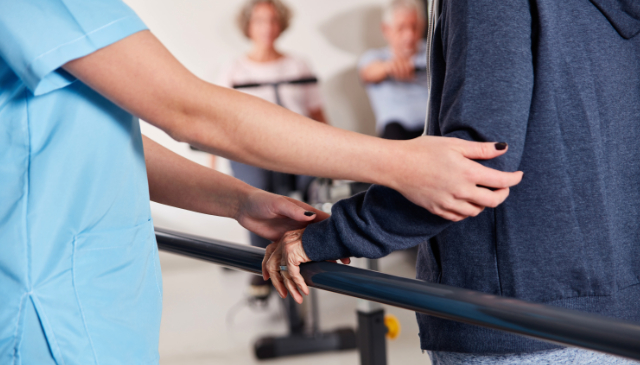News
How Physical Therapy Can Help Older Adults Stay on Their Feet

Falling might seem like a minor mishap to some people, but if you're an older adult, you know full well that a fall can be anything but “minor.” Depending on one's health, a simple fall can lead to serious injuries, reduced independence, and even life–threatening complications. Every year, more than one in four adults over the age of 65 suffers from a fall, and these incidents are the leading cause of injury–related hospitalizations in this population.
Although balance naturally declines with age, the good news is that many falls are preventable. Physical therapy in particular can play a crucial role in fall prevention, as personalized treatment programs will help older adults improve their balance, strength, and coordination, thereby reducing their fall risk. A recently published study sheds light on the factors contributing to falls and how targeted interventions can reduce risk. Let's take a closer look.
Understanding the fall landscape for older adults
Falls among older adults are not merely accidents. In most cases, a fall results from a complex combination of physical, environmental, and behavioral factors. Some of the most common factors that contribute to a fall include:
- Muscle weakness: loss of muscle mass with age can make movement less stable
- Poor balance: declines in vestibular (inner ear) function and proprioception (body awareness) affect stability
- Chronic conditions: arthritis, diabetes, and neurological disorders are among the many conditions that can increase fall risk
- Medication side effects: some medications cause dizziness, drowsiness, or low blood pressure
- Environmental hazards: clutter, poor lighting, and loose rugs can all lead to falls
When a fall occurs, the consequences can range widely from mild to devastating. For some, the result may be a serious injury like a hip fracture, which often requires surgical intervention and can lead to a lengthy recovery process. This may help explain why falls are the leading cause of injury among older adults, with a staggering $50 billion spent annually on medical costs related to these incidents in the U.S.
Given this alarming backdrop, it is crucial to explore the biomechanics of falls: how they happen and what can be done to minimize their prevalence. Researchers continue to study these dynamics in detail, gaining insights that can inform safety practices and preventive measures.
Mapping the biomechanics of falls to design better prevention programs
For these reasons, a study was conducted with the goal of developing a better understanding for fall dynamics. This comprehensive scoping review sought to map the existing research on real–life falls among older adults using video analysis technology. Researchers aimed to fill the gaps in knowledge about how falls occur and which factors can potentially mitigate the chances and severity of these events.
This involved identifying research from various electronic databases that utilized video footage to analyze biomechanics and fall configurations, protective responses, and impact severity. The findings were illuminating, as they revealed several critical insights:
- Impaired balance and reduced lower body strength were among the strongest predictors of falls
- Cognitive function also played a significant role in fall risk, as individuals with mild cognitive impairment had a higher overall risk
- Environmental factors, such as poor lighting and trip hazards, were frequently linked to fall incidents
- Structured exercise programs that focused on strength, balance, and mobility showed significant promise in reducing falls
These findings reinforce the idea that fall prevention should be a multifaceted approach that addresses both physical function and environmental safety.
How a physical therapist can reduce your fall risk
Physical therapists specialize in improving mobility, balance, and strength, which makes them a key player in fall prevention efforts. They can design personalized fall–prevention programs that involve a variety of targeted interventions, many of which were identified in the featured study, such as:
- Balance training: exercises that improve stability and coordination, such as single–leg stands or balance board work
- Strengthening exercises: focused resistance training to build lower body strength and enhance mobility
- Gait training: teaching proper walking mechanics to reduce stumbles and missteps
- Flexibility work: stretching routines to improve joint mobility and reduce stiffness
- Environmental assessments: guidance on making home modifications to minimize fall risks, such as adding grab bars and improving lighting
Contact us today to improve your personal safety
If you or a loved one is concerned with fall risk, our physical therapists are here to help. We understand the challenges that come with aging and the vital role that physical therapy can play in preventing the devastating consequences of falls. Our specialized therapists will work with you to create a personalized program aimed at enhancing strength, balance, and confidence.
For those interested in a deeper dive into the findings of the study, you can read the full article here.
Disclaimer:
The information in the articles, posts, and newsfeed is intended for informational and educational purposes only and in no way should be taken to be the provision or practice of physical therapy, medical, or professional healthcare advice or services. The information should not be considered complete or exhaustive and should not be used for diagnostic or treatment purposes without first consulting with your physical therapist, occupational therapist, physician or other healthcare provider. The owners of this website accept no responsibility for the misuse of information contained within this website.

